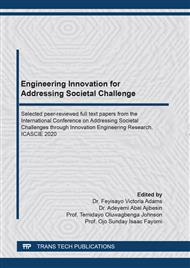[1]
R. Edwards et al., WHO Indoor Air Quality Guidelines: Household fuel Combustion - Review 2: Emissions of Health-Damaging Pollutants from Household Stoves,, (2014).
Google Scholar
[2]
A. Ghafoor, T. U. Rehman, A. Munir, M. Ahmad, and M. Iqbal, Current status and overview of renewable energy potential in Pakistan for continuous energy sustainability,, Renew. Sustain. Energy Rev., vol. 60 (2016) 1332–1342.
DOI: 10.1016/j.rser.2016.03.020
Google Scholar
[3]
H. M. Toonen, Adapting to an innovation: Solar cooking in the urban households of Ouagadougou (Burkina Faso),, Phys. Chem. Earth, vol. 34 (2009) 65–71.
DOI: 10.1016/j.pce.2008.03.006
Google Scholar
[4]
K. Das, G. Pradhan, and S. Nonhebel, Human energy and time spent by women using cooking energy systems: A case study of Nepal,, Energy, vol. 182 (2019) 493–501.
DOI: 10.1016/j.energy.2019.06.074
Google Scholar
[5]
J. Jung and M. Huxham, Firewood usage and indoor air pollution from traditional cooking fires in Gazi Bay, Kenya,, Biosci. Horizons, vol. 11, (2018). https://doi.org/10.1093/ biohorizons/hzy014.
DOI: 10.1093/biohorizons/hzy014
Google Scholar
[6]
A. G. Dagnachew, A. F. Hof, P. L. Lucas, and D. P. van Vuuren, Scenario analysis for promoting clean cooking in Sub-Saharan Africa: Costs and benefits,, Energy, vol. 192 (2020) 116641.
DOI: 10.1016/j.energy.2019.116641
Google Scholar
[7]
D. Stanistreet et al., Barriers and facilitators to the adoption and sustained use of cleaner fuels in southwest cameroon: Situating 'lay' knowledge within evidence-based policy and practice,, Int. J. Environ. Res. Public Health, vol. 16 (2019) 1–18.
DOI: 10.3390/ijerph16234702
Google Scholar
[8]
M. Dalaba et al., Liquified Petroleum Gas (LPG) Supply and Demand for Cooking in Northern Ghana,, Ecohealth, vol. 15 (2018) 716–728.
DOI: 10.1007/s10393-018-1351-4
Google Scholar
[9]
S. Jewitt, P. Atagher, and M. Clifford, 'We cannot stop cooking': Stove stacking, seasonality and the risky practices of household cookstove transitions in Nigeria,, Energy Res. Soc. Sci., vol. 61 (2020) 101340.
DOI: 10.1016/j.erss.2019.101340
Google Scholar
[10]
C. Raynes-Greenow et al., A feasibility study assessing acceptability and supply issues of distributing LPG cookstoves and gas cylinders to pregnant women living in rural Bangladesh for poriborton: The CHANge trial,, Int. J. Environ. Res. Public Health, vol. 17 (2020) 1–12.
DOI: 10.3390/ijerph17030848
Google Scholar
[11]
C. F. Gould and J. Urpelainen, The Gendered Nature of Liquefied Petroleum Gas Stove Adoption and Use in Rural India,, J. Dev. Stud., (2019) 1–21.
DOI: 10.1080/00220388.2019.1657571
Google Scholar
[12]
J. Goldemberg, J. Martinez-Gomez, A. Sagar, and K. R. Smith, Household air pollution, health, and climate change: Cleaning the air,, Environ. Res. Lett., vol. 13 (2018). https://doi.org/10.1088/1748-9326/aaa49d.
DOI: 10.1088/1748-9326/aaa49d
Google Scholar
[13]
S. Batchelor, E. Brown, N. Scott, and J. Leary, Two birds, one stone-reframing cooking energy policies in Africa and Asia,, Energies, vol. 12 (2019) 1–18.
DOI: 10.3390/en12091591
Google Scholar
[14]
A. Giwa, A. Alabi, A. Yusuf, and T. Olukan, A comprehensive review on biomass and solar energy for sustainable energy generation in Nigeria,, Renew. Sustain. Energy Rev., vol. 69, (2017) 620–641.
DOI: 10.1016/j.rser.2016.11.160
Google Scholar
[15]
Jumia online shop, Jumia Nigeria,, Jumia, 2020. [Online]. Available: https://www.jumia.com.ng/. [Accessed: 25-Mar-2020].
DOI: 10.12816/0050873
Google Scholar
[16]
National Bureau of Statistics,, National Bureau of Statistics, 2019.
Google Scholar
[17]
S. Batchelor , A.R Talukder, M.R. Uddin, S.K. Mondal, S. Islam, R.K Redoy, R. Hanlin and M.R. Khan Solar e-cooking: A proposition for solar home system integrated clean cooking,, Energies, vol. 11, no. 11, (2018) 1–14.
DOI: 10.3390/en11112933
Google Scholar


